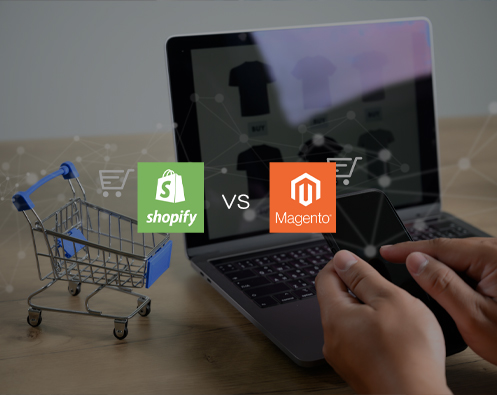
Magento Is Popular, It is Deep, It Works
Magento, an Adobe company now is one of the world’s most popular CMS systems and the online storefront of choice for millions of eCommerce customers, the platform supports billions of dollars in transactions.

#FocusOnTechnology
The way most companies sell has been transformed by the Internet, which has greatly expanded the reach of B2B and B2C businesses alike. Yet it’s safe to say that many are not getting the most from their online sales platform services.
What many online retailers need is a robust solution that works with your existing business systems to transform the online sales channel and bring a higher level of customer service to users. To this point, here are seven trends online sellers are using in eCommerce to play to customer interest, grab attention, drive traffic, increase market share, boost loyalty, and maximize revenues – all of which you can use to take online sales to the next level.

More people are becoming comfortable with voice search – according to a BrightLocal study, 58% of consumers used it to find information on a local business in the last year, with 46% doing it daily, and 50% of online queries expected to be done by voice search by next year.
This means voice assistants and voice shopping services through Amazon Echo and other digital home solution providers are also becoming more popular, the latter expected to jump from $2 billion currently to $40 billion in sales by 2022.
This shows why it’s so important for online sellers to take advantage of this growing opportunity by adjusting their eCommerce platform and product data to better fit online searches made through voice assistants, including understanding buyer context, providing longer, more detailed product descriptions, and using more conversational language.
Many people are now shopping on overseas websites. In fact, a Forbes survey across 24 countries and six continents showed that 57% of respondents had done so within the last six months of being surveyed, with numbers in some countries reaching the high seventies. They are looking for better pricing, product or service availability, and selection, and because of improved digital connectivity, consumers are less restricted by physical borders than ever before. In fact, a recent McKinsey report says that by 2020, people around the world will spend $1 trillion on cross-border eCommerce solutions, and to benefit from this trend, your company needs to use a technology platform that supports different languages, currencies, and taxes, among other things.
The popularity of online shopping doesn’t change the fact that many people still prefer visiting brick and mortar stores to visualize products. Augmented reality (AR) is trying to mitigate this downside of online shopping by making it easier for consumers to interact with a product, explore color and other options, and make personalized modifications. This includes allowing them to see what an item of clothing or jewelry would look like on them, or a piece of furniture in their homes, which not only improves customer satisfaction, but reduces returns.
These days, people expect B2B buying experiences to be responsive and personalized – just like those they are used to on B2C sites. B2B buying must now go beyond offering product information and online ordering to include specific catalogs and pricing, bulk discounts and ordering, restricted access, minimum order value/quantity, and terms payment options, among other online capabilities.
And with the digital revolution, customers also expect things to be intuitive, fast, and easy. They demand a self-service model with personalized and targeted B2B sales activities – such as analytics and delivery, returns, and exchange scheduling — from anywhere at any time. Other successful B2B online sales strategies include creating a tailored approach for each buyer; delivering a consistently high-quality buying experience at all stages of the sales cycle, regardless of preferred interaction channel; being mobile-enabled; offering fast and convenient online tools; providing sales reps an avenue to showcase products and sell in person; and leveraging data analytics to improve service.

With 92% of consumers saying they trust recommendations above all other forms of advertising, according to a Nielsen report, an increasing number of online sellers are turning to alternative strategies to promote their businesses. These include influencers, or those who have established credibility in a specific area, such as celebrities, bloggers, YouTube stars and others, who are actively using social media. While many companies can’t afford to hire celebrity spokespeople, they can leverage social media influencers who use Twitter, Instagram, YouTube, Snapchat, or Facebook to help them build awareness – which will lead to increased sales. In fact, 40% of Twitter users say they have purchased a product as a direct result of an influencer’s tweet. To make this strategy work, a company needs to identify ideal influencers, create meaningful content, and be able to measure performance to make sure they’re getting value from their investment.
With 92% of consumers saying they trust recommendations above all other forms of advertising, according to a Nielsen report, an increasing number of online sellers are turning to alternative strategies to promote their businesses. These include influencers, or those who have established credibility in a specific area, such as celebrities, bloggers, YouTube stars and others, who are actively using social media.
While many companies can’t afford to hire celebrity spokespeople, they can leverage social media influencers who use Twitter, Instagram, YouTube, Snapchat, or Facebook to help them build awareness – which will lead to increased sales. In fact, 40% of Twitter users say they have purchased a product as a direct result of an influencer’s tweet. To make this strategy work, a company needs to identify ideal influencers, create meaningful content, and be able to measure performance to make sure they’re getting value from their investment.
Finally, it’s more important than ever to win customer loyalty, and one way to do this is through online subscription box services. Subscription businesses, which include as meal kits, cosmetics, fashion, pet products, and more, send you a package (usually once a month) of items they’ve put together for you. According to McKinsey, this market has grown by more than 100% a year over the past five years, with 15% of shoppers signing on to receive products on a recurring basis. So you might consider adding this to your services to grow your business, but keep these things in mind: you have to know your target audience and what they want and personalize your services by capturing, understanding and making use of data to create a wonderful experience.
At Korcomptenz, we can help you better understand these vital industry trends by providing eCommerce solutions that might help transform your business. Some of these technologies are easy to implement; others can be more challenging. Regardless, we can help you assess your requirements and goals and come up with a plan that will help your company take advantage of the latest trends while remaining laser-focused on achieving your business vision. Request a consultation today!

Magento, an Adobe company now is one of the world’s most popular CMS systems and the online storefront of choice for millions of eCommerce customers, the platform supports billions of dollars in transactions.

2020 has been a challenging year for almost everyone outside the eCommerce industry. While most other businesses faced a loss in revenue due to the pandemic, eCommerce saw an almost 40% increase in sales.

The right eCommerce platform can drastically change your business, both online and off-line. They help to create better customer experiences and streamline operational efficiencies.
| Cookie | Duration | Description |
|---|---|---|
| cookielawinfo-checkbox-analytics | 11 months | This cookie is set by GDPR Cookie Consent plugin. The cookie is used to store the user consent for the cookies in the category "Analytics". |
| cookielawinfo-checkbox-functional | 11 months | The cookie is set by GDPR cookie consent to record the user consent for the cookies in the category "Functional". |
| cookielawinfo-checkbox-necessary | 11 months | This cookie is set by GDPR Cookie Consent plugin. The cookies is used to store the user consent for the cookies in the category "Necessary". |
| cookielawinfo-checkbox-others | 11 months | This cookie is set by GDPR Cookie Consent plugin. The cookie is used to store the user consent for the cookies in the category "Other. |
| cookielawinfo-checkbox-performance | 11 months | This cookie is set by GDPR Cookie Consent plugin. The cookie is used to store the user consent for the cookies in the category "Performance". |
| viewed_cookie_policy | 11 months | The cookie is set by the GDPR Cookie Consent plugin and is used to store whether or not user has consented to the use of cookies. It does not store any personal data. |